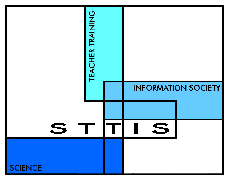Workshop 2
 Contents Contents
|
Section
J Relating to research case studies
| Activity
J1 |
Computer
modelling: research on teachers' transformations |
|
|
Aims
-
To consider some examples
of case studies involving
computer modelling.
-
To relate the case studies
to the general findings
of the research on teachers’ transformations.
-
To review your own
experience and compare it with
the case study material.
Background
The ‘stories’ that you looked
at in the first workshop,
about the ways in which teachers approach and implement curriculum
innovation,
were simplified accounts drawn from real case studies. They were
simplified
because they viewed the factors that affected teachers’ transformations
in isolation. Reality is more complex, since transformations are
brought
about not by single factors, but by factors that overlap and interact
with
each other. The case studies presented here attempt to capture some of
that complexity. The lessons of three teachers, Albert, Ivan and
Stewart
are presented in these case studies. They are all using a spreadsheet
to
teach about capacitor discharge, but they each use the software in
different
ways.
What to do
1. Read the case
studies in the document ‘Activity
Resource 1’ (Computer modelling: case studies).
2. Consider
the following questions in relation
to these case studies.
Albert
-
What appears to be
Albert’s primary objective in
using a computer model?
-
How does he view the
pupils’ competence in using
a spreadsheet? How does this influence what he does?
-
How does he support pupils
in constructing the model?
Ivan
-
What are Ivan’s longer
term objectives in teaching?
-
What were his shorter term
objectives?
-
Did the lesson go as
planned? How did he respond
to changes in circumstances?
Stewart
-
What is Stewart doing in
this lesson which is different
from what he has done in the past?
-
What view about the
relationship between model and
data is communicated to students?
-
To what extent is the
availability of resources a
critical factor?
3. Read the document
‘Activity
Resource 2’ (Transformation of curriculum innovation: dimensions of
analysis),
which gives a summary of some findings of the research into teachers’
transformations.
These findings are expressed in general terms, without examples from
particular
curriculum innovations. Can you relate any of the aspects identified in
this summary to the case studies or to your own experience?
|

 Teaching with computer models
Teaching with computer models

